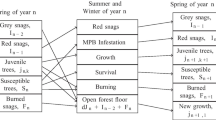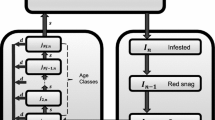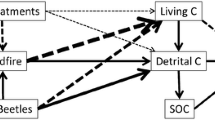Abstract
Predicted climate warming is expected to have profound effects on bark beetle population dynamics in the southwestern United States. Temperature-mediated effects may include increases in developmental rates, generations per year, and changes in habitat suitability. As a result, the impacts of Dendroctonus frontalis and Dendroctonus mexicanus on forest resources are likely subject to amplification. To assess the implications of such change, we evaluated the generations per year of these species under three climate scenarios using a degree-day development model. We also assessed economic impacts of increased beetle outbreaks in terms of the costs of application of preventative silvicultural treatments and potential economic revenues forgone. Across the southwestern USA, the potential number of beetle generations per year ranged from 1–3+ under historical climate, an increase of 2–4+ under the minimal warming scenario and 3–5+ under the greatest warming scenario. Economic benefits of applying basal area reduction treatments to reduce forest susceptibility to beetle outbreaks ranged from $7.75/ha (NM) to $95.69/ha (AZ) under historical conditions, and $47.96/ha (NM) to $174.58/ha (AZ) under simulated severe drought conditions. Basal area reduction treatments that reduce forest susceptibility to beetle outbreak result in higher net present values than no action scenarios. Coupled with other deleterious consequences associated with beetle outbreaks, such as increased wildfires, the results suggest that forest thinning treatments play a useful role in a period of climate warming.



Similar content being viewed by others
References
Ayres MP, Lombardero MJ (2000) Assessing the consequences of climate change for forest herbivores and pathogens. The Science of the Total Environment 262:263–286
Barkawi LS, Francke W, Blomquist GJ, Seybold SJ (2003) Frontalin: De novo biosynthesis of an aggregation pheromone component by Dendroctonus spp. bark beetles (Coleoptera: Scolytidae). Insect Biochemistry and Molecular Biology 33(8):773–788
Beal JA (1933) Temperature extremes as factors in the biology of southern pine beetle. Journal of Forestry 31:329–336
Breece CR, Kolb TE, Dickson BG, McMillin JD, Clancy KM (2007) Prescribed fire effects on bark beetle activity and tree mortality in southwestern ponderosa pine forests. Forest Ecology and Management 255:119–128
Breshears DD, Cobb NS, Rich PM, Price KP, Allen CD, Balice RG, Romme WH, Kastens JH, Floyd ML, Belnap J, Anderson JJ, Myers O, Meyerd CW (2005) Regional vegetation die-off in response to global-change-type drought. Proceedings of the National Academy of Sciences 102:15144–15148
Brooker RW, Travis JMJ, Clark EJ, Dytham C (2007) Modelling species’ range shifts in a changing climate: The impacts of biotic interactions, dispersal distance and the rate of climate change. Journal of Theoretical Biology 245:59–65
Brown DE, Lowe CH (1980) Biotic communities of the Southwest. U.S. Forest Service General Technical Report RM-73
Byers JA (1989) Behavioral mechanisms involved in reducing competition in bark beetles. Holarctic Ecology 12:466–476
Calkin DE, Gebert KM, Jones JG, Neilson RP (2005) Forest Service large fire area burned and suppression expenditure trends, 1970–2002. Journal of Forestry 103:179–183
Cibrian-Tovar D, Mendez-Montiel JT, Campos-Bolanos R, Yates HO, Flores-Lara J (1995) Insectos Forestales de Mexico. Universidad Autonoma Chapingo, Publication #6, 453 pp
Coppedge BR, Stephen FM, Felton GW (1994) Variation in size and lipid content of adult southern pine beetle, Dendroctonus frontalis Zimmerman (Coleoptera: Scolytidae) in relation to season. Journal of Entomological Science 29(4):570–579
Cooper CF (1960) Changes in vegetation, structure, and growth of southwestern ponderosa pine forests since white settlement. Ecological Monographs 30:129–164
Coulson RN (1979) Population dynamics of bark beetles. Annual Review of Entomology 24:417–447
Council of Economic Advisers (2007) Economic Report of the President. U.S. Government Printing Office, Washington, DC, USA, 358 pp
Covington WW, Fule PZ, Moore MM, Hart SC, Kolb TK, Mast JN, Sackett SS, Wagner MR (1997) Restoring ecosystem health in ponderosa pine forest of the Southwest. Journal of Forestry 95:23–29
Covington WW, Moore MM (1994) Post settlement changes in natural fire regimes and forest structure: ecological restoration of old-growth ponderosa pine forests. Journal of Sustainable Forestry 2:153–181
Cuéllar-Rodríguez G, Treviño-Garza EJ, Aguirre-Calderón OA, Jiménez-Pérez J (in press) Distribución de los principales insectos de importancia forestal en el estado de Nuevo León. Revista Ciencia UANL
Dale VH, Joyce LA, McNulty S, Neilson RP, Ayres MP, Flannigan MD, Hanson PJ, Irland LC, Lugo AE, Peterson CJ, Simberloff D, Swanson FJ, Stocks BJ, Wotton BM (2001) Climate change and forest disturbances. BioScience 51(9):723–734
DeGomez TE (2004) Arizona Forest Health Program (AZFH) Federal Federal FY 2004 report. University of Arizona School of Natural Resources and Cooperative Extension, Tucson, AZ, 39 pp
Feeney SR, Kolb TE, Covington WW, Wagner MR (1998) Influence of thinning and burning restoration treatments on presettlement ponderosa pines at the Gus Pearson Natural Area. Canadian Journal of Forest Research 28:1295–1306
Fettig CJ, Klepzig KD, Billings RF, Munsond AS, Nebeker TE, Negron JF, Nowak JT (2007) The effectiveness of vegetation management practices for prevention and control of bark beetle infestations in coniferous forests of the western and southern United States. Forest Ecology and Management 238:24–53
Friedenberg NA, Sarkar S, Kouchoukos N, Billings RF, Ayres MP (2008) Temperature extremes, density dependence, and southern pine beetle (Coleoptera: Curculionidae) population dynamics in east Texas. Environmental Entomology 37:650–659
Fulé PZ, Covington WW, Smith HB, Springer JD, Heinlein TA, Huisinga KD, Moore MM (2002) Comparing ecological restoration alternatives: Grand Canyon, Arizona. Forest Ecology and Management 170:19–41
Fulé PZ, Covington WW, Stoddard MT, Bertolette D (2006) “Minimal-impact” restoration treatments have limited effects on forest structure and fuels at Grand Canyon, USA. Restoration Ecology 14(3):357–368
Fulé PZ, Waltz AEM, Covington WW, Heinlein TA (2001) Measuring forest restoration effectiveness in hazardous fuels reduction. Journal of Forestry 99(11):24–29
Gagne JA, Wagner TL, Sharpe PJH, Coulson RN, Fargo WS (1982) Reemergence of Dendroctonus frontalis (Coleoptera: Scolytidae) at constant temperatures. Environmental Entomology 11:1216–1222
Gaylord ML, Kolb TE, Wallin KF, Wagner MR (2006) Seasonality and lure preference of bark beetles (Curculionidae: Scolytinae) and associates in a Northern Arizona Ponderosa Pine Forest. Environmental Entomology 35:37–47
Gaylord ML, Williams KK, Hofstetter RW, McMillin JD, DeGomez TE, Wagner MR (2008) Influence of temperature on spring flight initiation for southwestern ponderosa pine bark beetles (Coleoptera: Curculionidae, Scolytinae). Environmental Entomology 37:57–69
Haynes RW (tech. coor.) (2003) An analysis of the timber situation in the United States: 1952 to 2050. General Technical Report PNW-GTR-560, U.S. Department of Agriculture, Forest Service, Pacific Northwest Research Station, Portland, OR, 254 pp
Hofstetter RW, Cronin JT, Klepzig KD, Moser JC, Ayres MP (2006) Antagonisms, mutualisms, and commensalisms affect outbreak dynamics of the southern pine beetle. Oecologia 147:679–691
Hofstetter RW, Chen Z, Gaylord ML, McMillin JD, Wagner MR (2008) Synergistic effects of α-pinene and exo-brevicomin on pine bark beetles and associated insects in Arizona. Journal of Applied Entomology 132:387–397
Hulme PE (2005) Adapting to climate change: is there scope for ecological management in the face of a global threat? Journal of Applied Ecology 42:784–794
Keane RE, Cary GJ, Davies ID, Flannigan MD, Gardner RH, Lavorel S, Lenihan JM, Chao L, Rupp TS (2004) A classification of landscape fire succession models: spatial simulations of fire and vegetation dynamics. Ecological Modelling 179:3–27
Keeley JE (2006) Fire management impacts on invasive plants in the western United States. Conservation Biology 20:375–384
Kolb TE, Holmberg KM, Wagner MR, Stone JE (1998) Regulation of ponderosa pine foliar physiology and insect resistance mechanisms by basal area treatments. Tree Physiology 18:375–381
Lieutier F, Day K, Battisti A, Gregoire J-C, Evans J (2004) Bark and wood boring insects in living trees in Europe, a synthesis. Kluwer Academic Publishers, Dordrecht, The Netherlands, 569 pp
Loehle C (1996) Forest response to climate change. Journal of Forestry 94(9):13–15
Logan JA, Bentz BJ (1999) Model analysis of mountain pine beetle (Coleoptera: Scolytidae) seasonality. Environmental Entomology 28:924–934
Logan JA, Regniere J, Powell JA (2003) Assessing the impacts of global warming in forest pest dynamics. Frontiers in Ecology and Environment 1(3):130–137
Lombardero MJ, Ayres MP, Ayres BD, Reeve JD (2000) Cold tolerance of four species of bark beetle (Coleoptera : Scolytidae) in North America. Environmental Entomology 29:421–432
Long JN, Shaw JD (2005) A density management diagram for even-aged ponderosa pine stands. Western Journal of Applied Forestry 20(4):205–215
Millar CI, Stephenson NL, Stephens SL (2007) Climate change and forests of the future: managing in the face of uncertainty. Ecological Applications 17(8):2145–2151
McKenzie D, Gedalof Z, Peterson DL, Mote P (2004) Climatic change, wildfire, and conservation. Conservation Biology 18(4):890–902
Moser JC, Fitzgibbon BA, Klepzig KD (2005) The Mexican pine beetle, Dendroctonus mexicanus: First record in the United States and co-occurrence with the southern pine beetle—Dendroctonus frontalis (Coleoptera: Scolytidae or Curculionidae: Scolytidae). Entomological News 116(4):235–243
Moser JC, Macias-Samano JE (2000) Tarsonemid mite associates of Dendroctonus frontalis (Coleoptera: Scolytidae): implications for the historical biogeography of D. frontalis (Scholar, teacher, and mentor: a tribute to Professor John Borden). Canadian Entomologist 132(6):765–771
Neilson RP, Pitelka LF, Solomon AM, Nathan R, Midgley GF, Fragoso JMV, Lische H, Thompson K (2005) Forecasting regional to global plant migration in response to climate change. BioScience 55(9):749–759
Nowak J, Asaro C, Kelpzig K, Billings R (2008) The southern pine beetle prevention initiative: Working for healthier forests. Journal of Forestry 106(5):261–267
Oliver WW (1995) Is self thinning in ponderosa pine ruled by Dendroctonus beetles? In: Forest health through silviculture. Proceedings of the 1995 National Silviculture Workshop, Mescalero, NM, May8–11, 1995, pp 213–218
O’Brien RA (2002) Arizona’s Forest Resources, 1999. Resource Bulletin RMRS-RB-2. USDA Forest Service Rocky Mountain Research Station, Ogden, UT, 122 pp
O’Brien RA (2003) New Mexico’s Forest Resources, 2000. Resource Bulletin RMRS-RB-3. USDA Forest Service Rocky Mountain Research Station, Ogden, UT, 124 pp
O’Hara KL (1998) Silviculture for structural diversity: a new look at multiaged systems. Journal of Forestry 96(7):4–10
Olsen WK, Schmid JM, Mata SA (1996) Stand characteristics associated with mountain pine beetle infestations in ponderosa pine. Forest Science 42:310–327
Paine TD (1984) Seasonal response of ponderosa pine to inoculation of the mycangial fungi from the western pine beetle. Canadian Journal of Botany 62:551–555
Paine TD, Raffa KF, Harrington TC (1997) Interactions among scolytid bark beetles, their associated fungi, and live host conifers. Annual Review of Entomology 42:179–206
Parker TJ, Clancy KM, Mathiasen RL (2006) Interactions among fire, insects, and pathogens in coniferous forests of the interior western United States and Canada. Agricultural and Forest Entomology 8:167–189
Price TS, Dogett HC, Pye JM, Holmes TP (1990) A history of southern pine beetle outbreaks in the southeastern United States. The Georgia Forestry Commission, Macon, GA, 66 pp
Pyne SJ, Andrews PL, Laven RD (1996) Introduction to Wildland fire. John Wiley and Sons, Inc., New York, NY, 769 pp
Reineke LH (1933) Perfecting a stand-density index for even-aged forests. Journal of Agricultural Research 46(7):627–638
Samman S, Logan J (2000) Assessment and response to bark beetle outbreaks in the Rocky Mountain area. Report to Congress from Forest Health Protection, Washington Office, Forest Service, U.S. Department of Agriculture. General Technical Report, Rocky Mountain Research Station, USDA Forest Service, RMRS-GTR-62, Fort Collins, CO, 46 pp
Sanchez-Martinez G, Wagner MR (2002) Bark beetle community structure under four ponderosa pine forest stand conditions in northern Arizona. Forest Ecology and Management 170:145–160
Salinas-Moreno Y, Mendoza MG, Barrios MA, Cisneros R, Macías-Sámano J, Zuñiga G (2004) Areography of the genus Dendroctonus (Coleoptera: Curculionidae: Scolytinae) in Mexico. Journal of Biogeography 31:1163–1177
Sauvard D (2004) General biology of bark beetles. In: Synthesis A, Lieutier F, Day K, Battisti A, Gregoire J-C, Evans J (eds) Bark and wood boring insects in living trees in Europe. Kluwer Academic Publishers, Dordrecht The Netherlands, pp 63–88
Seager R, Ting MF, Held IM, Kushnir Y, Lu J, Vecchi G, Huang H-P, Harnik N, Leetmaa A, Lau N-C, Li C, Velez J, Naik N (2007) Model projections of an imminent transition to a more arid climate in southwestern North America. Science 316:1181–1184
Skov K, Kolb TE, Wallin KF (2005) Difference in radial growth response to restoration thinning and burning treatments between young and old ponderosa pine in Arizona. Western Journal of Applied Forestry 20:36–43
Snider G, Daugherty PJ, Wood D (2006) The irrationality of continued fire suppression: an avoided cost analysis of fire hazard reduction treatments versus no treatment. Journal of Forestry 104:431–437
Somme L (1982) Supercooling and winter survival in terrestrial arthropods. Comparative Biochemistry and Physiology 73A:519–543
Stireman JO III, Dyer LA, Janzen DH, Singer MS, Lill JT, Marquis RJ, Ricklefs RE, Gentry GL, Hallwachs W, Coley PD, Barone JA, Greeney HF, Connahs H, Barbosa P, Morais HC, Diniz IR (2005) Climatic unpredictability and parasitism of caterpillars: Implications of global warming. Proceedings of the National Academy of Sciences 102(48):17384–17387
Stone JE, Kolb TE, Covington WW (1999) Effects of restoration thinning on pre-settlement Pinus ponderosa in northern Arizona. Restoration Ecology 7:172–182
Thatcher RC, Barry PJ (1982) Southern pine beetle. Forest insect and disease leaflet 49. USDA Forest Service, Southern Forest Experiment Station, Pineville, LA, 7 pp
Tran JK, Ylioja T, Billings RF, Regniere J, Ayres MP (2007) Impact of minimum winter temperatures on the population dynamics of Dendroctonus frontalis. Ecological Applications 17(3):882–899
Ungerer MJ, Ayres MP, Lombardero MJ (1999) Climate and the northern distribution limits of Dendroctonus frontalis Zimmerman (Coleoptera: Scolytidae). Journal of Biogeography 26:1133–1145
USDA Forest Service (2001) Forest insect and disease conditions report, 1998–2000
USDA Forest Service Region 3 (2007) Transaction evidence appraisal bulletin no. 07 CY 07 3rd June, 2 pp
Vite JP, Islas SJ, Renwick AA, Hughes PR, Kliefoth RH (1974) Biochemical and biological variation of southern pine beetle populations in North and Central America. Zeitschrift Fur Angewandte Entomologie 75:422–435
Wagner TL, Gagne JA, Sharpe PJH, Coulson RN (1984) A biophysical model of southern pine beetle, Dendroctonus frontalis Zimmermann (Coleoptera: Scolytidae) development. Ecological Modeling 21:125–147
Wallin KF, Kolb TE, Skov KR, Wagner MR (2008) Forest management treatments, tree resistance, and bark beetle resources utilization in ponderosa pine forests of northern Arizona. Forest Ecology and Management 255:3263–3269
Walther GR, Post E, Convey P, Menzel A, Parmesan C, Beebee TJ, Fromentin JM, Hoegh-Guldberg O, Bairlein F (2002) Ecological responses to recent climate change. Nature 416:389–395
Waring KM, O′Hara KL (2005) Silvicultural strategies in forest ecosystems affected by introduced pests. Forest Ecology and Management 209:27–41
Washington WM, Weatherly JW, Meehl GA, Semtner AJ Jr, Bettge TW, Craig AP, Strand WG Jr, Arblaster J, Wayland VB, James R, Zhang Y (2000) Parallel Climate Model (PCM): control and transient simulations. Climate Dynamics 16(10–11):755–774
Williams DW, Liebhold AM (2002) Climate change and the outbreak ranges of two North American bark beetles. Agricultural and Forest Entomology 4:87–99
Williams KK, McMillin JD, DeGomez TE, Clancy KM, Miller A (2008) Influence of elevation on bark beetle (Coleoptera: Curculionidae, Scolytinae) community structure and flight periodicity in ponderosa pine forests of Arizona. Environmental Entomology 37(1):94–109
Wood DL (1982) The bark and ambrosia beetles of north and Central America (Coleoptera: Scolytidae), a taxonomic monograph. Great Basin Naturalist Memoirs 6, 1359 pp
Zausen GL, Kolb TE, Bailey JD, Wagner MR (2005) Long-term impacts of stand management on ponderosa pine physiology and bark beetle abundance in northern Arizona: A replicated landscape study. Forest Ecology and Management 218:291–305
Acknowledgments
This work was supported, in part, by the National Center for Ecological Analysis and Synthesis and The Nature Conservancy as part of a Distributed Graduate Seminar. We appreciate the interactions and feedback we received from the many individuals involved in the seminar.
Author information
Authors and Affiliations
Corresponding author
Rights and permissions
About this article
Cite this article
Waring, K.M., Reboletti, D.M., Mork, L.A. et al. Modeling the Impacts of Two Bark Beetle Species Under a Warming Climate in the Southwestern USA: Ecological and Economic Consequences. Environmental Management 44, 824–835 (2009). https://doi.org/10.1007/s00267-009-9342-4
Received:
Revised:
Accepted:
Published:
Issue Date:
DOI: https://doi.org/10.1007/s00267-009-9342-4




